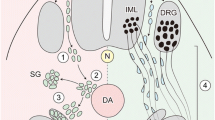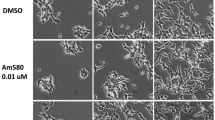Summary
The effects of Sonic hedgehog (Shh) signaling pathway activation on S-type neuroblastoma (NB) cell lines and its role in NB tumorigenesis were investigated. Immunohistochemistry was used to detect the expression of Shh pathway components—Patched1 (PTCH1) and Gli1 in 40 human primary NB samples. Western blotting and RT-PCR were used to examine the protein expression and mRNA levels of PTCH1 and Gli1 in three kinds of S-type NB cell lines (SK-N-AS, SK-N-SH and SHEP1), respectively. Exogenous Shh was administrated to activate Shh signaling pathway while cyclopamine was used as a selective antagonist of Shh pathway. S-type NB cell lines were treated with different concentrations of Shh or/and cyclopamine for different durations. Cell viability was measured by using MTT method. Apoptosis rate and cell cycle were assayed by flow cytometry. The xenograft experiments were used to evaluate the role of Shh pathway in tumor growth in immunodeficient mice. High-level expression of PTCH1 and Gli1 was detected in both NB samples and S-type NB cell lines. Cyclopamine decreased the survival rate of the three cell lines while Shh increased it, and the inhibition effects of cyclopamine could be partially reversed by shh pre-treatment. Cyclopamine induced the cell apoptosis and the cell cycle arrest in G0/G1 phase, while Shh induced the reverse effects and could partially prevent effects of cyclopamine. Cyclopamine could also inhibit the growth of NB in vivo. Our studies revealed that activation of the Shh pathway is important for survival and proliferation of S-type NB cells in vivo and in vitro through affecting cell apoptosis and cell cycle, suggesting a new therapeutic approach to NB.
Similar content being viewed by others
References
Menegaux F, Olshan AF, Neglia JP, et al. Day care, childhood infections, and risk of neuroblastoma. Am J Epidemiol, 2004,159(9):843–851
Lisewski D, Ryan S, Lim EM, et al. Concomitant composite adrenal pheochromocytoma, multiple gastric stromal tumors and pseudohermaphrodism in a patient with von Recklinghausen’s disease. Int Semin Surg Oncol, 2006,3:11
Dyer MA. Mouse models of childhood cancer of the nervous system. J Clin Pathol, 2004,57(6):561–576
Brodeur GM. Neuroblastoma: biological insights into a clinical enigma. Nat Rev Cancer, 2003,3(3):203–216
Maris JM, Matthay KK. Molecular biology of neuroblastoma. J Clin Oncol, 1999,17(7):2264–2279
Ahlgren SC, Bronner-Fraser M. Inhibition of sonic hedgehog signaling in vivo results in craniofacial neural crest cell death. Curr Biol, 1999,9(22):1304–1314
Fu M, Lui VC, Sham MH, et al. Sonic hedgehog regulates the proliferation, differentiation, and migration of enteric neural crest cells in gut. J Cell Biol, 2004,166(5): 673–684
Thayer SP, di Magliano MP, Heiser PW, et al. Hedgehog is an early and late mediator of pancreatic cancer tumorigenesis. Nature, 2003,425(6960):851–856
Karhadkar SS, Bova GS, Abdallah N, et al. Hedgehog signaling in prostate regeneration, neoplasia and metastasis. Nature, 2004,431(7009):707–712
Couvé-Privat S, Le Bret M, Traiffort E, et al. Functional analysis of novel sonic hedgehog gene mutations identified in basal cell carcinomas from xeroderma pigmentosum patients. Cancer Res, 2004,64(10):3559–3565
Daya-Grosjean L, Couvé-Privat S. Sonic hedgehog signaling in basal cell carcinomas. Cancer Lett, 2005, 225(2):181–192
Hooper JE, Scott MP. Communicating with Hedgehogs. Nat Rev Mol Cell Biol, 2005,6(4):306–317
Riobo NA, Manning DR. Pathways of signal transduction employed by vertebrate Hedgehogs. Biochem J, 2007, 403(3):369–379
Rubin LL, de Sauvage FJ. Targeting the Hedgehog pathway in cancer. Nat Rev Drug Discov, 2006,5(12): 1026–1033
De Preter K, Vandesompele J, Heimann P, et al. Human fetal neuroblast and neuroblastoma transcriptome analysis confirms neuroblast origin and highlights neuroblastoma candidate genes. Genome Bio, 2007,8(1):401
Mao L, Xia YP, Zhou YN, et al. A critical role of Sonic Hedgehog signaling in maintaining the tumorigenicity of neuroblastoma cells. Cancer Sci, 2009,100(10):1848–1855
Bar EE, Chaudhry A, Farah MH, et al. Hedgehog signaling promotes medulloblastoma survival via Bc/II. Am J Pathol, 2007,170(1):347–355
Kenney AM, Rowitch DH. Sonic hedgehog promotes G (1) cyclin expression and sustained cell cycle progression in mammalian neuronal precursors. Mol Cell Biol, 2000,20(23):9055–9067
Gartel AL, Serfas MS, Tyner AL. p21-negative regulator of the cell cycle. Proc Soc Exp Biol Med, 1996,213(2): 138–149
Yoon JW, Kita Y, Frank DJ, et al. Gene expression profiling leads to identification of Gli1-binding elements in target genes and a role for multiple downstream pathways in Gli1-induced cell transformation. J Biol Chem, 2002,277(7):5548–5555
Xie J, Aszterbaum M, Zhang X, et al. A role of PDGFRalpha in basal cell carcinoma proliferation. Proc Natl Acad Sci U S A, 2001,98(16):9255–9259
Teh MT, Wong ST, Neill GW, et al. FOXM1 is a downstream target of Gli1 in basal cell carcinomas. Cancer Res, 2002,62(16):4773–4780
Ohta M, Tateishi K, Kanai F, et al. p53-independent negative regulation of p21/cyclin-dependent kinase-interacting protein 1 by the sonic hedgehog-glioma-associated oncogene 1 pathway in gastric carcinoma cells. Cancer Res, 2005,65(23):10 822–10 829
Mao L, Xia YP, Zhou YN, et al. Activation of sonic hedgehog signaling pathway in olfactory neuroblastoma. Oncology, 2009,77(3–4):231–243
Morton JP, Mongeau ME, Klimstra DS, et al. Sonic hedgehog acts at multiple stages during pancreatic tumorigenesis. Proc Natl Acad Sci USA, 2007,104(2): 5103–5108
Author information
Authors and Affiliations
Corresponding authors
Additional information
These author contributed equally to this work.
This project was supported by a grant from the National Natural Sciences Foundation of China (No. 30600189).
Rights and permissions
About this article
Cite this article
Zhou, Y., Dai, R., Mao, L. et al. Activation of sonic hedgehog signaling pathway in S-type neuroblastoma cell lines. J. Huazhong Univ. Sci. Technol. [Med. Sci.] 30, 271–277 (2010). https://doi.org/10.1007/s11596-010-0342-7
Received:
Published:
Issue Date:
DOI: https://doi.org/10.1007/s11596-010-0342-7




